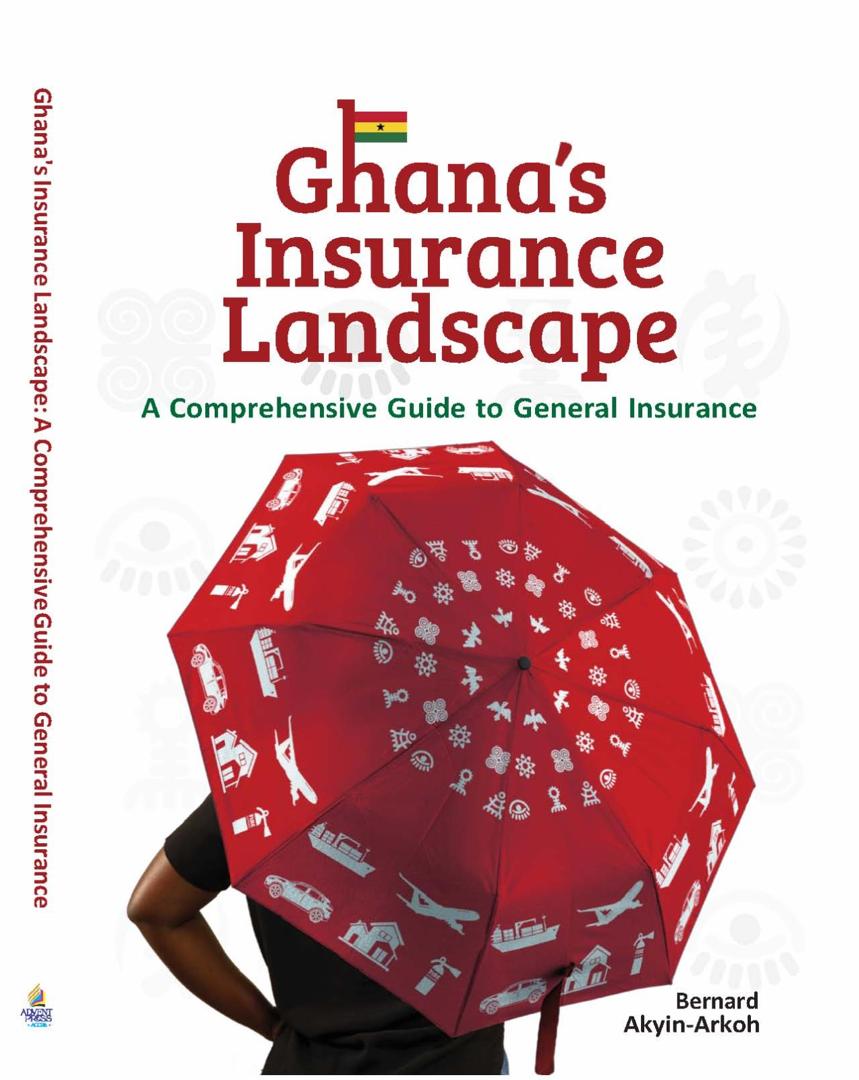
Ghana’s Insurance Landscape: A Comprehensive Guide to General Insurance is an authoritative resource that provides an in-depth overview of the Ghanaian insurance industry. It sheds light on regulatory frameworks, key industry players, growth opportunities, challenges, and the sector’s contribution to national economic development.
This book explores the foundational principles that serve as the bedrock of the insurance sector, before moving into an in-depth analysis of the key distribution channels that connect insurers with the public. It then offers a meticulous examination of all general insurance policies underwritten in Ghana—covering definitions, scope of cover, exclusions, underwriting requirements, and claims management. The final chapter provides clarity on commonly used insurance terminologies, serving as a practical glossary for professionals and learners alike.
Chapter Outlines
Chapter One: Overview of the Ghanaian Insurance Industry
This opening chapter introduces readers to the Ghanaian insurance landscape. It traces the history and evolution of the industry, explains the regulatory environment, and highlights the key players shaping the market today. Readers will also gain insights into gross premium growth, the pressing challenges facing insurers, and the emerging opportunities for innovation and expansion. The chapter concludes by examining how the insurance sector contributes to economic development, job creation, and financial stability in Ghana.
Chapter Two: Principles of Insurance
Here, the book lays the foundation by defining what insurance is and explaining the law of contract that underpins every insurance agreement. The chapter goes further to explore the special principles unique to insurance—such as insurable interest, utmost good faith, indemnity, contribution, and subrogation. These principles form the backbone of every policy, helping readers understand not just what insurance does, but how and why it works the way it does.
Chapter Three: Insurance Distribution Channels
Insurance products reach the public through different channels, and this chapter explores them all. From direct distribution (where insurers sell directly to customers) to indirect channels (including brokers, agents, bancassurance, and digital platforms), readers will discover how insurers connect with their clients. The chapter also reflects on how digitalization and InsurTech are transforming access, making insurance more convenient, affordable, and inclusive.
Chapter Four: Motor Insurance Policy
Motor insurance is the most widely purchased insurance product in Ghana—and also one of the most regulated. This chapter covers the compulsory nature of motor insurance, the various types of motor policies available (Third Party, Third Party Fire & Theft, Comprehensive), policy exclusions, and the underwriting requirements for vehicles. It also provides a step-by-step look into claims management, making it a practical guide for both motorists and professionals.
Chapter Five: Fire Insurance Policy
Fires remain one of the most devastating risks for businesses and households alike. This chapter defines fire insurance, explains the compulsory fire cover mandated in Ghana, and details what is (and isn’t) covered. It highlights the importance of fire insurance in protecting businesses and properties, reviews underwriting requirements, and walks through the claims process. Readers will see how fire insurance safeguards investments and promotes resilience.
Chapter Six: Public Liability Insurance Policy
Public liability insurance protects businesses and individuals from third-party claims for injury, death, or property damage. This chapter explains the compulsory aspects of public liability insurance in Ghana, outlines its coverage and exclusions, and provides guidance on underwriting requirements and claims processes. Real-life examples illustrate how this policy shields organizations from financial ruin when accidents occur in the course of business.
Chapter Seven: Money Insurance Policy
Money is vulnerable when in transit or stored, and this chapter focuses on protecting it. Readers will learn about the different types of money insurance—covering cash in transit, cash in safes, and cash at business premises. The chapter discusses general exclusions and provides practical insight into claims management, making it essential for financial institutions, retail businesses, and fuel stations.
Chapter Eight: Marine Insurance Policy
Global trade depends heavily on marine insurance, and this chapter unpacks its principles and history. It explains compulsory marine cover in Ghana, the different types of marine insurance (cargo, hull & machinery, and P&I), and why they matter for businesses involved in shipping and logistics. The chapter also highlights the importance of marine insurance in protecting against the unpredictable risks of transport, alongside practical claims handling guidance.
Chapter Nine: Professional Indemnity Insurance Policy
Professional services are growing in Ghana, and with them, the risks of negligence or errors. This chapter defines professional indemnity insurance and discusses compulsory requirements in some professions. It outlines coverage, exclusions, and underwriting considerations, while also detailing how claims are handled. It is an essential read for professionals such as doctors, lawyers, accountants, engineers, and consultants.
Chapter Ten: Goods in Transit Insurance Policy
Transporting goods is risky business. This chapter explores the scope of cover for goods in transit, from theft to damage caused by accidents. It explains the underwriting requirements that ensure proper valuation and protection, the common exclusions to note, and the claims process. Traders, transporters, and logistics companies will find this chapter especially relevant.
Chapter Eleven: Workmen’s Compensation / Employers Liability Insurance Policy
This chapter reviews the Workmen’s Compensation Act of 1987 (PNDC Law 187) and explains employers’ responsibility to protect employees. It discusses policy coverage, exclusions, underwriting, and claims processes. The chapter emphasizes how workmen’s compensation and employer liability insurance not only fulfill legal obligations but also protect both employers and workers in case of workplace injuries or fatalities.
Chapter Twelve: Personal Accident Insurance Policy
Life is unpredictable, and accidents can disrupt individuals and families. This chapter examines different types of personal accident cover, policy scope, exclusions, and underwriting requirements. It also compares personal accident insurance with workmen’s compensation to highlight their distinct features. Readers gain an understanding of how this policy provides financial security in times of personal crisis.
Chapter Thirteen: Travel Insurance Policy
Travel brings unique risks, from medical emergencies abroad to lost luggage. This chapter defines travel insurance, details its coverage, exclusions, and underwriting requirements, and explains the claims process. It also touches on how travel insurance has become a requirement for visa applications, making it highly relevant for today’s global travelers.
Chapter Fourteen: Comprehensive Homeowners Insurance Policy
For most families, a home is their largest investment. This chapter explores homeowners insurance, covering the structure, household contents, and sometimes personal liability. It explains what is excluded, what underwriting entails, and how claims are managed. The chapter demonstrates how this policy provides peace of mind by protecting against fire, theft, flood, and other risks.
Chapter Fifteen: Construction and Engineering Insurance Policies
Large construction projects carry enormous risks. This chapter introduces policies like Contractors All Risks (CAR), Erection All Risks (EAR), Plant & Machinery, and Boiler & Pressure Vessel insurance. It explains coverage, exclusions, underwriting requirements, and claims handling, showing how these policies support infrastructure growth and project financing in Ghana.
Chapter Sixteen: Insurance Terminologies
The book closes with a practical glossary of insurance terms. This chapter explains technical language in simple terms, ensuring that readers—whether professionals, students, or business owners—can confidently navigate the insurance world.Why This Book Matters
This book is written to serve a broad audience:
- Insurance professionals and risk management firms will find it a reliable reference to strengthen their practice.
- Students and researchers can use it as a comprehensive academic resource.
- Business owners and individuals will discover practical guidance to protect their assets and make informed insurance decisions.
At its heart, the book is not just a technical manual—it is a trusted guide that simplifies the complexities of insurance and demonstrates its vital role in safeguarding lives, businesses, and national development.
A Personal Note from the Author
Having spent close to a decade in the Ghanaian insurance industry, I have witnessed firsthand the transformative power of knowledge. Insurance, though often perceived as complex, is simply a mechanism for protection and financial security—helping individuals and businesses anticipate, manage, and recover from unexpected events.
Through this book, I invite you on a journey into Ghana’s insurance landscape: from its foundations and principles to its diverse policies and distribution models. May it be a source of knowledge, empowerment, and confidence as you navigate the path of risk protection and financial resilience.

